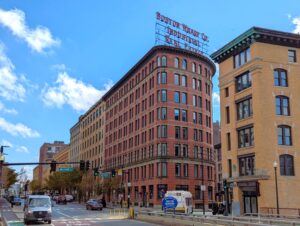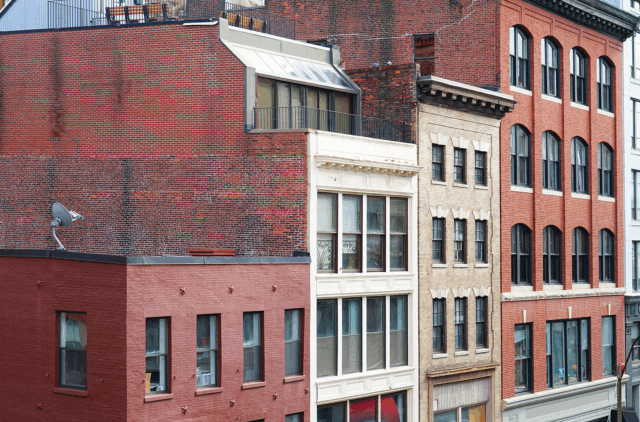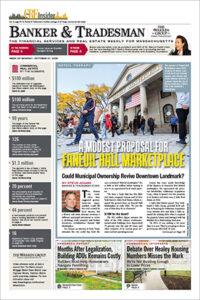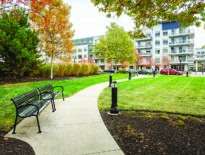
Burns Realty is currently converting 263 Summer St. into 77 units, while keeping the iconic “Boston Wharf Co.” sign on the building’s roof. Photo by James Sanna | Banker & Tradesman Staff
Boston’s office-to-housing conversion program is starting to face the same problem that’s plagued the residential real estate market for years now: lack of inventory.
The conversion program, which was launched two years ago by Mayor Michelle Wu, hasn’t produced a lot of new housing units, at least not yet.
Only one conversion project, at 281 Franklin St., has been completed so far, totaling 15 units. Three other conversion projects – at 263 Summer St., 129 Portland St. and 615 Albany St. – are currently under construction, for an additional 126 units.
But the Office to Residential Conversion Program, as it’s officially known, is generating growing interest among developers in conversion projects around the city.
How Many Conversions So Far?
As of mid-October, the city of Boston has received 18 applications to convert 23 older buildings into residential housing, totaling 934 housing units, 172 of them income restricted.
That’s up from 16 applications and 780 units (142 of them income restricted) in July, according to data from the city’s Department of Planning.
Of the 934 proposed and existing units now on the books, 11 projects accounting for 595 units have been approved by the Boston Planning and Development Agency board.
And more proposals – and city approvals — are expected before the program is due to expire at the end of this calendar year.
In a statement, a spokeswoman for the city’s Planning Department didn’t say if the Wu administration plans to extend the conversion program beyond 2025, adding only: “We encourage developers to submit applications now if they are interested in the program. …We are encouraged by the enthusiasm for the office-to-residential conversion program.”
Developers contacted by Banker & Tradesman said they hope the Wu administration indeed extends the program, which, among other things, provides a 75 percent tax abatement for 29 years as a financial incentive to produce new housing via conversions.
The program also requires projects set aside 20 percent of its units for affordable housing and abide by the expensive state Stretch Energy Code.
The conversion program was launched in 2023 in response to the dramatic plunge in demand for office buildings, due to the pandemic-era rise of remote work.
The idea behind the conversion program: reduce the surplus supply of office space in the city while at the same time producing desperately needed new housing.
“The program has been successful so far,” said Adam Burns, owner of Burns Realty, which has already converted 281 Franklin St. and is currently converting 263 Summer St. into 77 units, while keeping the iconic “Boston Wharf Co.” sign on the building’s roof.
“The conversion program’s incentives help make the numbers work,” said Burns.

Office and residential buildings in Boston’s Leather District. The neighborhood was the site of many office-to-residential conversions in the 1990s. iStock photo
Too Many Builders, Not Enough Buildings
Noam Ron, co-owner of the Hudson Group, which hopes to convert some buildings in the city, agreed that the program should be extended beyond the end of 2025.
“There seems to be real momentum behind it,” he said. “We’re seeing buyers and lenders getting increasingly more comfortable with the idea of [office-to-residential] conversions.”
But Burns and Ron agreed that there’s another barrier that might prevent many more conversions: a lack of older buildings that are suitable for conversions.
“Finding the right buildings is the greatest challenge that we’re facing right now,” he said. “It’s hard to find [buildings] that make the numbers work.”
Compounding the problem: There are now more development players looking to buy buildings to convert.
Like residential real estate in general, the conversion program is now grappling with high demand and limited supply.
“It’s getting more competitive and price pressures are building,” said Burns.
Ron, whose family-owned business converted older commercial buildings in the Leather District into housing in the 1990s, said his firm recently bid on some older buildings that it was looking to convert – only to lose out to other developers.
“There’s a growing pool of buyers out there, but there’s only a limited supply of buildings that can be converted,” he said. “It’s very challenging.”
What Works for Conversions
In general, developers are eying older brick-and-mortar office buildings, usually built before World War II, for potential conversions.
Theoretically, that means potentially millions of square feet of class B office space might be in play for conversions in Boston.
But theoretical isn’t the same as realistic when it comes to what exactly makes a building suitable for a conversion.
“Every building is unique,” said Burns. “It’s hard to apply a rule-of-thumb to what’s acceptable. It changes from building to building.”
Among other things, developers are looking at the geometic layout of buildings, floor plates, the number of stairways and elevator shafts, hallway widths, window placements, utility hookups, and other features.
Conversions can oftentimes cost less to build than ground-up construction. Then again, they can sometimes match or even exceed the costs of ground-up construction.
It all depends on the building’s design and condition.
Speed to Market Key to Financing
But Burns said conversion projects have a clear advantage over ground-up projects, if the right buildings can be found. Speed.
The time it takes to start and finish a conversion project is usually much shorter than a ground-up development, due to excavation, foundation, exterior and basic utilities work already being done when construction starts.
“It can shave off a lot of time on a project,” said Burns of conversion projects in general. “Time is money.”
Add in the fact that Wu’s program includes an expedited review process, and conversions look even more attractive, he noted.
Burns said he expects to announce his firm’s third conversion proposal by the end of the year.
After that, he said he’s not sure how many more, if any, projects his firm might pursue considering the escalating competition for suitable buildings to convert.
Ron said he’s hoping Hudson Group can convert “one or two projects in this cycle” – if he can find and buy suitable properties to convert.
“There just not a lot of inventory out there,” he said.





